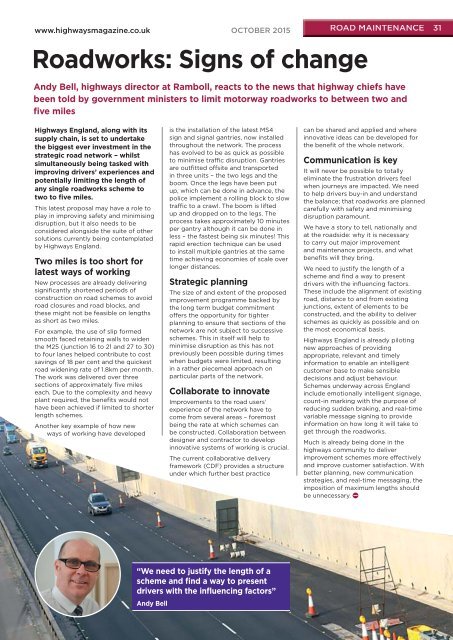Andrew Jones
Highways_October_2015
Highways_October_2015
You also want an ePaper? Increase the reach of your titles
YUMPU automatically turns print PDFs into web optimized ePapers that Google loves.
www.highwaysmagazine.co.uk OCTOBER 2015<br />
ROAD MAINTENANCE 31<br />
Roadworks: Signs of change<br />
Andy Bell, highways director at Ramboll, reacts to the news that highway chiefs have<br />
been told by government ministers to limit motorway roadworks to between two and<br />
five miles<br />
Highways England, along with its<br />
supply chain, is set to undertake<br />
the biggest ever investment in the<br />
strategic road network – whilst<br />
simultaneously being tasked with<br />
improving drivers’ experiences and<br />
potentially limiting the length of<br />
any single roadworks scheme to<br />
two to five miles.<br />
This latest proposal may have a role to<br />
play in improving safety and minimising<br />
disruption, but it also needs to be<br />
considered alongside the suite of other<br />
solutions currently being contemplated<br />
by Highways England.<br />
Two miles is too short for<br />
latest ways of working<br />
New processes are already delivering<br />
significantly shortened periods of<br />
construction on road schemes to avoid<br />
road closures and road blocks, and<br />
these might not be feasible on lengths<br />
as short as two miles.<br />
For example, the use of slip formed<br />
smooth faced retaining walls to widen<br />
the M25 (junction 16 to 21 and 27 to 30)<br />
to four lanes helped contribute to cost<br />
savings of 18 per cent and the quickest<br />
road widening rate of 1.8km per month.<br />
The work was delivered over three<br />
sections of approximately five miles<br />
each. Due to the complexity and heavy<br />
plant required, the benefits would not<br />
have been achieved if limited to shorter<br />
length schemes.<br />
Another key example of how new<br />
ways of working have developed<br />
is the installation of the latest MS4<br />
sign and signal gantries, now installed<br />
throughout the network. The process<br />
has evolved to be as quick as possible<br />
to minimise traffic disruption. Gantries<br />
are outfitted offsite and transported<br />
in three units – the two legs and the<br />
boom. Once the legs have been put<br />
up, which can be done in advance, the<br />
police implement a rolling block to slow<br />
traffic to a crawl. The boom is lifted<br />
up and dropped on to the legs. The<br />
process takes approximately 10 minutes<br />
per gantry although it can be done in<br />
less – the fastest being six minutes! This<br />
rapid erection technique can be used<br />
to install multiple gantries at the same<br />
time achieving economies of scale over<br />
longer distances.<br />
Strategic planning<br />
The size of and extent of the proposed<br />
improvement programme backed by<br />
the long term budget commitment<br />
offers the opportunity for tighter<br />
planning to ensure that sections of the<br />
network are not subject to successive<br />
schemes. This in itself will help to<br />
minimise disruption as this has not<br />
previously been possible during times<br />
when budgets were limited, resulting<br />
in a rather piecemeal approach on<br />
particular parts of the network.<br />
Collaborate to innovate<br />
Improvements to the road users’<br />
experience of the network have to<br />
come from several areas – foremost<br />
being the rate at which schemes can<br />
be constructed. Collaboration between<br />
designer and contractor to develop<br />
innovative systems of working is crucial.<br />
The current collaborative delivery<br />
framework (CDF) provides a structure<br />
under which further best practice<br />
can be shared and applied and where<br />
innovative ideas can be developed for<br />
the benefit of the whole network.<br />
Communication is key<br />
It will never be possible to totally<br />
eliminate the frustration drivers feel<br />
when journeys are impacted. We need<br />
to help drivers buy-in and understand<br />
the balance; that roadworks are planned<br />
carefully with safety and minimising<br />
disruption paramount.<br />
We have a story to tell, nationally and<br />
at the roadside: why it is necessary<br />
to carry out major improvement<br />
and maintenance projects, and what<br />
benefits will they bring.<br />
We need to justify the length of a<br />
scheme and find a way to present<br />
drivers with the influencing factors.<br />
These include the alignment of existing<br />
road, distance to and from existing<br />
junctions, extent of elements to be<br />
constructed, and the ability to deliver<br />
schemes as quickly as possible and on<br />
the most economical basis.<br />
Highways England is already piloting<br />
new approaches of providing<br />
appropriate, relevant and timely<br />
information to enable an intelligent<br />
customer base to make sensible<br />
decisions and adjust behaviour.<br />
Schemes underway across England<br />
include emotionally intelligent signage,<br />
count-in marking with the purpose of<br />
reducing sudden braking, and real-time<br />
variable message signing to provide<br />
information on how long it will take to<br />
get through the roadworks.<br />
Much is already being done in the<br />
highways community to deliver<br />
improvement schemes more effectively<br />
and improve customer satisfaction. With<br />
better planning, new communication<br />
strategies, and real-time messaging, the<br />
imposition of maximum lengths should<br />
be unnecessary.<br />
“We need to justify the length of a<br />
scheme and find a way to present<br />
drivers with the influencing factors”<br />
Andy Bell



